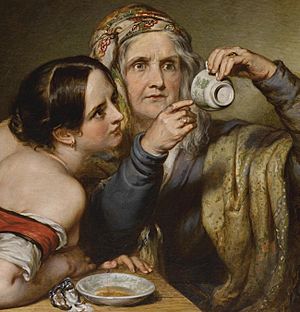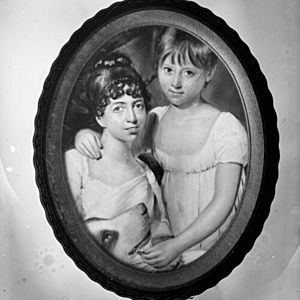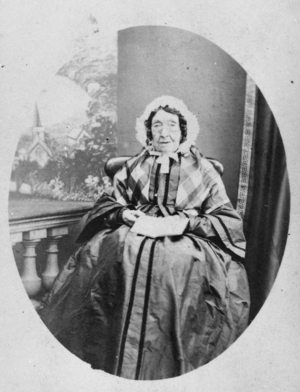Mary Ann McCracken facts for kids
Mary Ann McCracken (born July 8, 1770 – died July 26, 1866) was a strong voice for change in Belfast, Ireland. Her many letters give us a great look into her life and times. She came from a well-known Presbyterian family who believed in freedom and fairness. Mary Ann was a successful businesswoman in Belfast's growing textile industry. She also supported the United Irishmen, who wanted more democracy. She fought for women's rights, helped poor people get education and relief, and worked her whole life to end slavery. In 2021, Belfast City Council decided to put up a statue of Mary Ann McCracken at Belfast City Hall.
Contents
- Growing Up and What Shaped Her
- A Businesswoman and Fair Employer
- Lover of Irish Music and Language
- A United Irishwoman
- Her Brother's Execution
- Friendship with Russell and Hope
- Fighting for Women's Equality
- A Dedicated Helper of Others
- Fighting to End Slavery
- The Union and the Famine
- Later Life and Legacy
- Biographies
Growing Up and What Shaped Her
Mary Ann McCracken was born in Belfast on July 8, 1770. Her father, Captain John McCracken, was a shipowner and helped build the town's first cotton mill in 1784. He was a very religious Presbyterian.
Her mother, Ann Joy, came from a French Huguenot family who made money in the linen business. They also started the Belfast News Letter newspaper. Ann Joy was unusual because she ran her own shop before getting married. She later managed a small business making fine cloth called muslin. She greatly admired Thomas Paine, a writer who believed in freedom.
Mary Ann and her older brother, Henry Joy ("Harry"), went to David Manson's special "play school." This school was different because it tried to make learning fun and treated boys and girls equally. Mary Ann loved math and reading there.
In 1788, Mary Ann and Harry tried to start their own Sunday school for poor children. Unlike other schools at the time, they didn't force children to go to church or learn religious lessons. Because of this, a local church leader and some ladies stopped their school.
The McCracken family was very interested in politics. Belfast was buzzing with ideas from the American Revolution. Their minister, Sinclair Kelburn, supported the Volunteer movement. This group allowed Presbyterians to arm themselves and meet freely. Kelburn spoke out for Catholic rights and fair government. Mary Ann's niece said that growing up with these influences made Mary Ann deeply care about politics from a young age.
A Businesswoman and Fair Employer
In the 1790s, Mary Ann and her sister Margaret started a business making patterned muslin cloth. At first, people worked from their homes. By 1809, they had a factory where young women learned to do embroidery.
Their business closed in 1815 after a war caused less demand for their products. But during tough times before that, the sisters were known for being fair employers. They refused to cut costs by firing their workers, especially young female embroiderers. Mary Ann said she couldn't fire workers because "nobody would give them employment." She also noted that there were "so few roads open" for women to work.
Mary Ann saw how machines were changing the textile industry in Belfast. She was fascinated by how machines could replace hard labor. She wondered if machines could help with chores like washing clothes. She hoped that machines would make work easier, give people more free time, and allow them to get more education.
Lover of Irish Music and Language
The musician Edward (Atty) Bunting lived with the McCracken family for 30 years starting in 1784. Mary Ann and Harry went to the Belfast Harp Festival that Bunting organized in July 1792. This festival celebrated Irish music.
In 1808, Mary Ann helped start the Belfast Harp Society with her friends, including poet Mary Balfour. Bunting was the music director, and Arthur O'Neill was the master teacher. Mary Ann helped Bunting with his work and secretly contributed to his book The Ancient Music of Ireland in 1809.
The Harp Society also offered classes in the Irish language. Mary Ann studied Irish grammar, showing her interest in preserving Irish culture.
A United Irishwoman
Mary Ann McCracken almost certainly joined the United Irishmen. This group wanted to unite all Irish people and create a fair government for everyone. She likely joined with her brothers, Harry, William, and Francis, who were all members. She wrote to Harry in 1797 about her hopes that others would join too. Her biographer, Mary McNeill, said it would be "out of keeping with her character" for Mary Ann to ask others to do something she wouldn't do herself.
At this time, the United Irishmen were thinking about a rebellion with help from France. Mary Ann was not afraid of political violence if it meant achieving a "complete Union of Ireland." She was also willing to hide guns and deceive authorities. However, she was against killing informers, saying, "what is morally wrong can never be politically right." She also noted that "almost everybody in Belfast" was learning French, showing their hope for French support.
When her brother Harry was in prison, Mary Ann urged him to get along with other prisoners. She said their disagreements were "injurious to the cause."
In 1798, when the United Irish leaders in Dublin called for a rebellion, Harry took charge in Antrim. He led thousands of rebels, but they failed to capture Antrim Town, suffering heavy losses.
Her Brother's Execution
After the rebellion failed, Mary Ann helped Harry and other rebels with money, food, and clothes. She was arranging for a ship to take Harry to America when he was caught on July 7, 1798. She visited him in prison and received a ring from him with a shamrock and the words "Remember Orr," referring to William Orr, another United Irishman who had been executed.
Mary Ann was present at Harry's trial in Belfast. On the same afternoon, she walked with him to the gallows. Harry refused to betray his friends to save his life. Mary Ann was given his body, and she tried to have a doctor revive him, but it was too late.
Friendship with Russell and Hope
Mary Ann wrote to Thomas Russell, another United Irishman, expressing her hope that their cause would still succeed. Five years later, in 1803, she met Russell, who was trying to start another rebellion. She and her sister Margaret advised him that people were not ready for another uprising.
After Russell was arrested, Mary Ann helped pay for his legal defense. She even tried to bribe officials to free him. After he was executed, she paid for his burial and helped his sister. Mary Ann admired Russell greatly, calling him "a model of manly beauty." They shared a strong belief in social justice.
She also had a lasting friendship with James (Jemmy) Hope until his death in 1847. Hope, who worked with laborers, believed that Harry and Russell truly understood the problems faced by working people.
Fighting for Women's Equality
Mary Ann McCracken had read Mary Wollstonecraft's Vindication of the Rights of Women (1792), a book about women's rights. In 1797, she wrote to her brother that women needed to escape their "dependent situation" to be truly free and happy. She believed that if women were meant to be companions to men, they must be equal in understanding.
She was skeptical of separate women's groups within the republican movement. She thought that keeping women separate would only keep them "in the dark" and make them "tools."
She asked her brother, "Is it not almost time... that the female part of Creation as well as the male should throw off the fetter...?" She hoped that Ireland could show an example of fairness and justice better than any nation before.
Although the United Irish societies didn't officially state their views on women's rights, their newspaper did encourage women to be part of public discussions.
A Dedicated Helper of Others

Mary Ann McCracken cared deeply about the living and working conditions of poor people. She spent her life helping them. As a child, she helped raise money and provide clothes for children at Clifton House, a charity home.
After 1800, she often made suggestions to the Belfast Charitable Society about the well-being of women and children. In 1827, she helped form the Ladies Committee of the Belfast Charitable Society. Thanks to their efforts, a school and nursery were set up for the children in the Poorhouse.
Mary Ann wanted the children to have a good education, not just basic care. She insisted on good teachers and believed children should read worthwhile books, get rewards, and have time for outdoor play. She argued that the poor should benefit from their own work, just like wealthier people.
Even in her late eighties, Mary Ann continued her charity work. She was president of the Belfast Ladies’ Industrial National School for Girls, visited the town's Lancastrian school, collected funds for the sick, managed the Ladies’ Clothing Society, and fought to stop the use of climbing boys for chimney sweeping. She believed it was better "to wear out than rust out."
In 1861, at age 90, she was still collecting for four charities and had "brilliant hope" that slavery would end in the United States.
Fighting to End Slavery
Mary Ann's father, Captain John McCracken, was involved in trade with the West Indies. But in 1786, when some merchants wanted to start shipping enslaved people, Thomas McCabe, a friend of the McCrackens, rallied people in Belfast against it. This opposition was strengthened by a visit in 1791 from Olaudah Equiano, a famous formerly enslaved person and author.
Mary Ann wore a special brooch with the image of an enslaved person and the words "Am I not a man and brother." She also boycotted sugar, which was produced by enslaved labor. She was a lifelong activist against slavery. She believed that the arguments used to justify slavery were similar to those used to deny women's rights.
After Frederick Douglass, another famous formerly enslaved person, visited Belfast in 1845, Mary Ann helped create the Ladies Anti-Slavery Association. This group corresponded with abolitionists in the United States and sent items to be sold at anti-slavery events.
By 1859, Mary Ann was sad to report that Belfast, once known for its love of liberty, had fewer people actively fighting slavery. She, at nearly 89, was one of the few left handing out anti-slavery leaflets to people traveling to the United States, where slavery was still a major issue.
In one of her last letters, Mary Ann was happy to record that the 13th Amendment to the U.S. Constitution, which ended slavery, was approved in December 1865.
The Union and the Famine
Mary Ann McCracken did not share the anger many felt when the government decided to abolish the Irish Parliament and bring Ireland under the British Parliament in Westminster. She felt that England had always treated Ireland unfairly. She wondered if a formal union would "increase the sufferings of the poor," especially the "wretched cottagers of the south" who barely had enough to eat.
She did not see the point in fighting for an Irish Parliament that mostly served wealthy landlords. After the Acts of Union (1801), she focused on other issues. She wrote to the Belfast News Letter urging factory owners to care for the health and safety of their workers, especially children.
By 1837, Mary Ann felt that things were getting better. She wrote that those who had died earlier would have been "delighted" by the peaceful political changes, like Catholic Emancipation (1829) and parliamentary reform (1832). She also likely thought of Britain's abolition of slavery in its colonies (1833) and the Factory Act (1833), which regulated child labor. She believed that public opinion was slowly moving towards fairer ideas.
It's not clear how her optimism held up during the Great Famine (1845-1849), when many Irish people starved. She collected money for the Belfast Ladies Association for the Relief of Irish Destitution, a group that helped people regardless of their religion. She also visited the first ragged school in Ireland, which helped poor children without trying to change their beliefs.
Later Life and Legacy
After her brother Harry was executed in 1798, Mary Ann learned he had a four-year-old daughter named Maria. Harry had been worried about Maria's future. Mary Ann took Maria in and raised her as her own daughter. Mary Ann herself never married.
Mary Ann's sister Margaret also remained single. They lived with their brother Francis and Maria at 62 Donegall Pass in Belfast. Maria later cared for Mary Ann in her own married home, where Mary Ann died on July 26, 1866, at 96 years old. Mary Ann McCracken is buried in Clifton Street Cemetery, where her niece and later her brother Harry were also buried.
The writer Alice Milligan (1866-1953) said she was greatly influenced by a family servant who had cared for Mary Ann McCracken. Milligan later became a key figure in remembering the 1798 rebellion and celebrated the United Irishmen's idea of unity beyond religion and social class.
Mary Ann worked with historian Madden on his book The United Irishmen, their lives and times. Madden said that Mary Ann herself wrote the part about her brother Henry Joy McCracken. She was very thorough, contacting many people to gather information about the United Irishmen. Madden's work is still an important source of information today.
In January 2021, the Belfast Charitable Society started The Mary Ann McCracken Foundation. This foundation aims to teach people about Mary Ann's work as a social reformer and to continue her legacy by promoting education, fighting poverty, and advancing human rights and equality.
In May 2021, Belfast City Council decided to put up a statue of Mary Ann McCracken on the grounds of Belfast City Hall.
Biographies
- The Life and Times of Mary Ann McCracken 1770 – 1866: A Belfast Panorama. Mary McNeill, Dublin: Irish Academic Press, (1960) 2019.
- Mary Ann McCracken 1770-1866: Feminist, Revolutionary and Reformer, John Gray, Belfast: Reclaim the Enlightenment, 2020.
- The Letters and Legacy of Mary Ann McCracken (1770-1866), Cathryn Bronwyn McWilliams, Åbo, Finland: Åbo Akademi University Press, 2021
External links
- The Dictionary of National Biography
- Mary Ann McCracken, Social Reformer
- Mary Ann McCracken Foundation on the Belfast Charitable Society site




